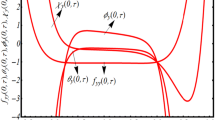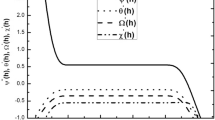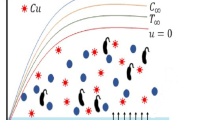Abstract
The significant bioconvection phenomenon with the utilization of nanoparticles encountered fundamental industrial and technological applications in recent years. This communication addressed the bioconvection phenomenon in the flow of magnetized Williamson nanoparticles with additional features of activation energy and heat absorption/generation. The analysis has been suggested by imposing the interesting features of the second-order slip effects and convective Nield boundary constraints. The flow problem based on the relevant laws results in a set of partial differential equations which are further retarded into ordinary differential forms. The numerical approach based on shooting algorithm is introduced to impose the numerical solution by using MATLAB software. The flow parameters governed with the flow equations are graphically explored with associated physical consequences. The numerical division for local Nusselt number, local Sherwood number and motile number is presented while assigning diverse values to the involved parameters. The reported theoretical simulations can be more effective to enhance the thermal extrusion processes and solar energy systems. It is observed that the presence of first- and second-order slip parameters significantly controls the associated boundary layers of velocity, temperature, concentration and gyrotactic microorganism profiles.














Similar content being viewed by others
Abbreviations
- \( v \) :
-
Kinematic viscosity
- \( \sigma \) :
-
Electrical conductivity
- \( \rho_{{\rm p}} \) :
-
Liquid density
- \( \alpha_{1} \) :
-
Thermal diffusivity
- \( Q_{0} \) :
-
Heat source coefficient
- \( \rho_{{\rm f}} \) :
-
Nanoparticles density
- \( D_{{\rm T}} \) :
-
Thermophoretic constant
- \( W_{{\rm c}} \) :
-
Speed of gyrotactic cell
- \( {{\rm Kr}} \) :
-
Chemical reaction
- \( \beta_{1} \) :
-
Molecular mean path
- \( \varGamma \) :
-
Curvature parameter
- \( M \) :
-
Hartmann number
- \( {{\rm Nc}} \) :
-
Bioconvection Rayleigh number
- \( {{\rm Nt}} \) :
-
Thermophoresis parameter
- \( \Pr \) :
-
Prandtl number
- \( \lambda \) :
-
Heat source/sink parameter
- \( {{\rm Pe}} \) :
-
Peclet number
- \( \varOmega_{1} \) :
-
Concentration difference parameter
- \( B \) :
-
Second-order slip
- \( {{\rm Nu}}_{{\rm x}} \) :
-
Local Nusselt number
- \( {{\rm Nn}}_{{\rm x}} \) :
-
Motile density number
- \( \varGamma_{1} \) :
-
Williamson fluid parameter
- \( g \) :
-
Gravity
- \( B_{0} \) :
-
Magnetic field strength
- \( \rho_{{\rm m}} \) :
-
Motile microorganism particles density
- \( C \) :
-
Volume fraction constant
- \( T \) :
-
Nanoparticles temperature
- \( D_{{\rm B}} \) :
-
Brownian motion constant
- \( b^{ * } \) :
-
Chemotaxis constant
- \( \tilde{\alpha } \) :
-
Momentum coefficient
- \( K_{{\rm n}} \) :
-
Knudsen number
- \( \varOmega \) :
-
Weissenberg number
- \( \varLambda \) :
-
Mixed convection parameter
- \( {{\rm Nr}} \) :
-
Buoyancy ratio parameter
- \( {{\rm Nb}} \) :
-
Brownian motion
- \( {{\rm Le}} \) :
-
Lewis number
- \( \gamma \) :
-
Biot number
- \( {{\rm Lb}} \) :
-
Bioconvection Lewis number
- \( A \) :
-
First-order slip
- \( {\rm Re}_{{\rm x}}^{{ - \frac{1}{2}}} \) :
-
Local Reynolds number
- \( {{\rm Sh}}_{{\rm x}} \) :
-
Local Sherwood number
References
Choi SUS. Enhancing thermal conductivity of fluids with nanoparticles. In: International Mechanical Engineering Congress and Exposition, ASME, FED 231/MD 66; 1995. p. 99–105.
Khan WA, Irfan M, Khan M, Alshomrani AS, Alzahrani AK, Alghamdi MS. Impact of chemical processes on magneto nanoparticle for the generalized Burgers fluid. J Mol Liq. 2017;234:201–8.
Sheikholeslami M. Lattice Boltzmann method simulation for MHD non-Darcy nanofluid free convection. Phys B. 2017;516:55–71.
Hayat T, Rashid M, Imtiaz M, Alsaedi A. Nanofluid flow due to rotating disk with variable thickness and homogeneous-heterogeneous reactions. Int J Heat Mass Transf. 2017;113:96–105.
Irfan M, Khan M, Khan WA. Numerical analysis of unsteady 3D flow of Carreau nanofluid with variable thermal conductivity and heat source/sink. Results Phys. 2017. https://doi.org/10.1016/j.rinp.2017.08.029.
Khan SU, Ali N, Abbas Z. Influence of heat generation/absorption with convective heat and mass conditions in unsteady flow of Eyring Powell nanofluid over porous oscillatory stretching surface. J Nanofluids. 2016;5(3):351–62.
Zuhra S, Khan NS, Khan MA, Islam S, Khan W, Bonyah E. Flow and heat transfer in water based liquid film fluids dispensed with graphene nanoparticles. Results Phys. 2018;8:1143–57.
Waqas H, Imran M, Khan SU, Shehzad SA, Meraj MA. Slip flow of Maxwell viscoelasticity-based micropolar nano particles with porous medium: a numerical study. Appl Math Mech (English Edition). 2019;40(9):1255–68.
Tlili I, Khan WA, Ramadan K. MHD flow of nanofluid flow across horizontal circular cylinder: steady forced convection. J Nanofluids. 2019;8(1):179–186(8).
Ganesh Kumar K, Ramesh GK, Gireesha BJ, Gorla RSR. Characteristics of Joule heating and viscous dissipation on three-dimensional flow of Oldroyd B nanofluid with thermal radiation. Alex Eng J. 2018;57(3):2139–49.
Ahamed SM, Mondal S, Sibanda P. Unsteady mixed convection flow through a permeable stretching flat surface with partial slip effects through MHD nanofluid using spectral relaxation method. Open Phys. 2017;15:323–34.
Waqas H, Khan SU, Tlili I, Awais M, Shadloo MS. Significance of bioconvective and thermally dissipation flow of viscoelastic nanoparticles with activation energy features: novel biofuels significance. Symmetry. 2020;12(2):214.
Zhang Z, Xie Y, Zhang D, Xie G. Flow characteristic and heat transfer for non-Newtonian nanofluid in rectangular microchannels with teardrop dimples/protrusions. Open Phys. 2017;15:197–206.
Khan SU, Shehzad SA. Brownian movement and thermophoretic aspects in third grade nanofluid over oscillatory moving sheet. Phys Scr. 2019;94(9):095202.
Waqas H, Khan SU, Shehzad SA, Imran M. Radiative flow of Maxwell nanofluids containing gyrotactic microorganism and energy activation with convective Nield conditions. Heat Transf Asian Res. 2019;48:1663–87.
Abdollahzadeh Jamalabadi MY, Alamian R, Yan W-M, Li LKB, Leveneur S, Safdari Shadloo M. Effects of nanoparticle enhanced lubricant films in thermal design of plain journal bearings at high Reynolds numbers. Symmetry. 2019;11(11):1353. https://doi.org/10.3390/sym11111353.
Abdollahzadeh Jamalabadi MY, Ghasemi M, Alamian R, Wongwises S, Afrand M, Safdari Shadloo M. Modeling of subcooled flow boiling with nanoparticles under the influence of a magnetic field. Symmetry. 2019;11(10):1275. https://doi.org/10.3390/sym11101275.
Abdollahzadeh Jamalabadi MY, Ghasemi M, Alamian R, Afshari E, Wongwises S, Mehdi Rashidi M, Safdari Shadloo M. A 3D simulation of single-channel high-temperature polymer exchange membrane fuel cell performances. Appl Sci. 2019;9(17):3633. https://doi.org/10.3390/app9173633.
Xiong Q, Khosravi A, Nabipour N, Doranehgard M, Sabaghmoghadam A, Ross D. Nanofluid flow and heat transfer due to natural convection in a semi-circle/ellipse annulus using modified lattice Boltzmann method. Int J Numer Methods Heat Fluid Flow. 2019;29(12):4746–63. https://doi.org/10.1108/HFF-03-2019-0273.
Gholamalipour P, Siavashi M, Doranehgard MH. Eccentricity effects of heat source inside a porous annulus on the natural convection heat transfer and entropy generation of Cu–water nanofluid. Int Commun Heat Mass Transf. 2019;109:104367.
Mesbah M, Vatani A, Siavashi M, Doranehgard MH. Parallel processing of numerical simulation of two-phase flow in fractured reservoirs considering the effect of natural flow barriers using the streamline simulation method. Int J Heat Mass Transf. 2019;131:574–83.
Siavashi M, Karimi K, Xiong Q, Doranehgard MH. Numerical analysis of mixed convection of two-phase non-Newtonian nanofluid flow inside a partially porous square enclosure with a rotating cylinder. J Therm Anal Calorim. 2019;137:267. https://doi.org/10.1007/s10973-018-7945-9.
Bemani A, Xiong Q, Baghban A, Habibzadeh S, Mohammadi AH, Doranehgard MH. Modeling of cetane number of biodiesel from fatty acid methyl ester (FAME) information using GA-, PSO-, and HGAPSO-LSSVM models. Renew Energy. 2019. https://doi.org/10.1016/j.renene.2019.12.086.
Asadi A, Kadijani ON, Doranehgard MH, Bozorg MV, Xiong Q, Shadloo MS, Li LKB. Numerical study on the application of biodiesel and bioethanol in a multiple injection diesel engine. Renew Energy. 2019. https://doi.org/10.1016/j.renene.2019.11.088.
Zhang W, Maleki A, Rosen MA. A heuristic-based approach for optimizing a small independent solar and wind hybrid power scheme incorporating load forecasting. J Clean Prod. 2019;241(20):117920.
Komeilibirjandi A, Raffiee AH, Maleki A, Nazari MA, Shadloo MS. Thermal conductivity prediction of nanofluids containing CuO nanoparticles by using correlation and artificial neural network. J Therm Anal Calorim. 1–11, First Online: 23 September 2019.
Li J, Mohammadi A, Maleki A. Techno-economic analysis of new integrated system of humid air turbine, organic Rankine cycle and parabolic trough collector. J Therm Anal Calorim. 1–13, First Online: 05 October 2019.
Shadloo MS. Numerical simulation of compressible flows by lattice Boltzmann method. Numer Heat Transf Part A. 2019;75(3):167–82.
Hosseini SM, Safaei MR, Goodarzi M, Alrashed AAAA, Nguyen TK. New temperature, interfacial shell dependent dimensionless model for thermal conductivity of nanofluids. Int J Heat Mass Transf. 2017;114:207–10.
Akbari OA, Toghraie D, Karimipour A. Impact of ribs on flow parameters and laminar heat transfer of water–aluminum oxide nanofluid with different nanoparticle volume fractions in a three-dimensional rectangular. Adv Mech Eng. 2015;7(11):1687814015618155.
Karimipour A. New correlation for Nusselt number of nanofluid with Ag/Al2O3/Cu nanoparticles in a microchannel considering slip velocity and temperature jump by using lattice Boltzmann method. Int J Therm Sci. 2015;91:146–56.
Bahrami M, Akbari M, Karimipour A, Afrand M. An experimental study on rheological behavior of hybrid nanofluids made of iron and copper oxide in a binary mixture of water and ethylene glycol: non-Newtonian behavior. Exp Therm Fluid Sci. 2016;79:231–7.
Almasi F, Shadloo MS, Hadjadj A, Ozbulut M, Tofighi N, Yildiz M. Numerical simulations of multi-phase electro-hydrodynamics’ flows using a simple incompressible smoothed particle hydrodynamics method. Comput Math Appl. 2019. https://doi.org/10.1016/j.camwa.2019.10.029.
Goshayeshi HR, Safaei MR, Goodarzi M, Dahari M. Particle size and type effects on heat transfer enhancement of Ferro-nanofluids in a pulsating heat pipe. Powder Technol. 2016;301:1218–26.
Hassan M, Sadri R, Ahmadi G, Dahari M, Kazi S, Safaei M, et al. Numerical study of entropy generation in a flowing nanofluid used in micro-and minichannels. Entropy. 2013;15(1):144–55.
Hopp-Hirschler M, Shadloo MS, Nieken U. Viscous fingering phenomena in the early stage of polymer membrane formation. J Fluid Mech. 2019;864:97–140.
Hopp-Hirschler M, Shadloo MS, Nieken U. A smoothed particle hydrodynamics approach for thermo-capillary flows. Comput Fluids. 2018;176:1–19.
Nadeem S, Hussain ST, Lee C. Flow of a Williamson fluid over a stretching sheet. Braz J Chem Eng. 2013;30(03):619–25.
Akbari A, Saidi MH. Experimental investigation of nanofluid stability on thermal performance and flow regimes in pulsating heat pipe. J Therm Anal Calorim. 2019;135:1835. https://doi.org/10.1007/s10973-018-7388-3.
Khan W, Gul T, Idrees M, Islam S, Khan I. Dufour and Soret effect with thermal radiation on the nano film flow of Williamson fluid past over an unsteady stretching sheet. J. Nanofluids. 2017;6:243–53.
Shah Z, Bonyah E, Islam S, Khan W, Ishaq M. Radiative MHD thin film flow of Williamson fluid over an unsteady permeable stretching sheet. Heliyon. 2018;4:e00825.
Khan SU, Shehzad SA, Ali N. Interaction of magneto-nanoparticles in Williamson fluid flow over convective oscillatory moving surface. J Braz Soc Mech Sci Eng. 2018;40:195.
Malik MY, Bibi M, Khan F, Salahuddin T. Numerical solution of Williamson fluid flow past a stretching cylinder and heat transfer with variable thermal conductivity and heat generation/absorption. AIP Adv. 2016;6:035101. https://doi.org/10.1063/1.4943398.
Bilal M, Sagheer M, Hussain S. Numerical study of magnetohydrodynamics and thermal radiation on Williamson nanofluid flow over a stretching cylinder with variable thermal conductivity. Alex Eng J. 2018;57:3281–9.
Kuznetsov AV. The onset of nanofluid bioconvection in a suspension containing both nanoparticles and gyrotactic microorganisms. Int Commun Heat Mass Transf. 2010;37(10):1421–5.
Kuznetsov AV. Nanofluid bioconvection in water-based suspensions containing nanoparticles and oxytactic microorganisms: oscillatory instability. Nanoscale Res Lett. 2011;6:100.
Mutuku WN, Makinde OD. Hydromagnetic bioconvection of nanofluid over a permeable vertical plate due to gyrotactic microorganisms. Comput Fluids. 2014;95:88–97.
Beg OA, Uddin J, Khan WA. Bioconvective non-Newtonian nanofluid transport in porous media containing micro-organisms in a moving free stream. J Mech Med Biol. 2015;15(5):1550071.
Uddin MJ, Kabir MN, Beg OA. Computational investigation of Stefan blowing and multiple-slip effects on buoyancy-driven bioconvection nanofluid flow with microorganisms. Int J Heat Mass Transf. 2016;95:116–30.
Acharya N, Das K, Kundu PK. Framing the effects of solar radiation on magneto-hydrodynamics bioconvection nanofluid flow in presence of gyrotactic microorganisms. J Mol Liq. 2016;222:28–37.
Khan M, Irfan M, Khan WA. Impact of nonlinear thermal radiation and gyrotactic microorganisms on the Magneto-Burgers nanofluid. Int J Mech Sci. 2017;130:375–82.
Bhatti MM, Zeeshan A, Ellahi R. Simultaneous effects of coagulation and variable magnetic field on peristaltically induced motion of Jeffrey nanofluid containing gyrotactic microorganism. Microvasc Res. 2017;110:32–42.
Waqas H, Khan SU, Imran M, Bhatti MM. Thermally developed Falkner–Skan bioconvection flow of a magnetized nanofluid in the presence of motile gyrotactic microorganism: Buongiorno’s nanofluid model. Phys Scr. 2019;94(11):115304.
Waqas H, Khan SU, Hassan M, Bhatti MM, Imran M. Analysis for bioconvection flow of modified second grade fluid containing gyrotactic microorganisms and nanoparticles. J Mol Liq. 2019;291(1), Article number: 111231.
Bhatti MM, Mishra SR, Abbas T, Rashidi MM. A mathematical model of MHD nanofluid flow having gyrotactic microorganisms with thermal radiation and chemical reaction effects. Neural Comput Appl. 2018;30(4):1237–49.
Wu L. A slip model for rarefied gas flows at arbitrary Knudsen number. Appl Phys Lett. 2008;93(25):253103.
Nandeppanavar MM, Vajravelu K, Abel MS, Siddalingappa M. Second order slip flow and heat transfer over a stretching sheet with non-linear Navier boundary condition. Int J Therm Sci. 2012;58:143–50.
Khan SU, Waqas H, Shehzad SA, Imran M. Theoretical analysis for tangent hyperbolic nanoparticles with combined electrical MHD, activation energy and Wu’s slip features: a mathematical model. Phys Scr. 2019;94(12):125211.
Ibrahim W. Magnetohydrodynamic (MHD) boundary layer stagnation point flow and heat transfer of a nanofluid past a stretching sheet with melting. Propuls Power Res. 2017;6(3):214–22.
Khan SU, Waqas H, Bhatti MM, Imran M. Bioconvection in the rheology of magnetized Couple stress nanofluid featuring activation energy and Wu’s slip. J Non-Equilib Thermodyn. 2020;45(1):81–95.
Author information
Authors and Affiliations
Corresponding author
Additional information
Publisher's Note
Springer Nature remains neutral with regard to jurisdictional claims in published maps and institutional affiliations.
Rights and permissions
About this article
Cite this article
Abdelmalek, Z., Khan, S.U., Waqas, H. et al. A mathematical model for bioconvection flow of Williamson nanofluid over a stretching cylinder featuring variable thermal conductivity, activation energy and second-order slip. J Therm Anal Calorim 144, 205–217 (2021). https://doi.org/10.1007/s10973-020-09450-z
Received:
Accepted:
Published:
Issue Date:
DOI: https://doi.org/10.1007/s10973-020-09450-z




